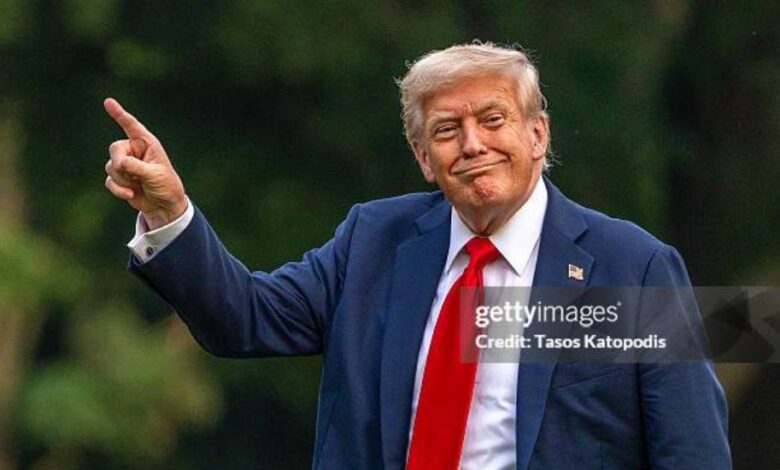Trump Flag: Symbol, Protest, and Politics

The American flag has long stood as a powerful emblem of liberty, democracy, and national pride. Over centuries, it has been revered, saluted, and draped over coffins in military funerals. But in recent years, a new chapter has been added to its complex legacy — a chapter written by former President Donald Trump and his fervent supporters. Dubbed informally as the “Trump flag,” this new wave of symbolism has sparked passionate debates over patriotism, politics, and the very fabric of American identity.
In this article, we will explore the evolution of the Trump flag, examine whether Trump changed the flag itself, analyze the new visual symbols tied to the Trump movement, and dissect the intense public reaction they’ve generated. The rise of Trump-themed flags is more than just a merchandising trend — it’s a case study in modern American culture wars.
1. Did Trump Change the American Flag? A Factual Clarification
Let’s start by clearing up one of the most persistent rumors: Donald Trump did not change the official design of the American flag. The Stars and Stripes remain untouched in terms of structure and law. The United States flag, with its 13 red and white stripes and 50 stars representing the states, is protected under the U.S. Flag Code and constitutional guidelines. No administration, including Trump’s, has legally altered it.
However, what Trump did do is amplify the flag’s symbolic presence in unprecedented ways — both as a personal brand marker and a campaign emblem. His 2016 and 2020 campaigns leaned heavily on flag imagery, MAGA aesthetics, and patriotic slogans. Supporters began embracing modified versions of the American flag, adorned with Trump’s name, slogans like “Keep America Great,” and even dates like “Trump 2024.”
2. The Rise of the “New Trump Flag”
A wide array of Trump-themed flags began surfacing during the 2016 and 2020 campaigns. Some featured the American flag with Trump’s name across the stripes, while others replaced stars with bold statements like “No More Bull****.” These were not official flags sanctioned by any government, but rather merchandise and symbols of allegiance.
Common variations included:
-
Blue Trump 2020 Flags: With white letters, stars, and the slogan “Keep America Great.”
-
Thin Blue Line Trump Flags: Merging pro-law enforcement imagery with Trump loyalty.
-
American Flags with Trump’s Face or Silhouette: Combining national symbolism with the cult of personality.
These flags became fixtures at Trump rallies, on suburban lawns, in pickup trucks, and even boats. A now-famous event, the “Trump Boat Parade,” saw hundreds of boats in places like Florida and Texas hoisting Trump flags alongside (or instead of) the U.S. flag.
3. The Flagpoles at the White House: Trump’s Personal Project
While he didn’t redesign the American flag, Trump did make headlines by installing two massive 100-foot flagpoles on the White House’s North and South Lawns in June 2025. According to public statements, Trump personally funded the $100,000 cost of this initiative. The gesture was symbolic — Trump emphasized that the White House had been “missing proper flagpoles for over 200 years.”
For many supporters, this action reflected Trump’s deep commitment to American heritage. For critics, it was viewed as a self-promotional move wrapped in patriotism. Either way, these flagpoles became yet another stage for the flag — and, by extension, Trump himself.
4. Flag as Protest: The January 6 Capitol Incident
Perhaps the darkest association with Trump flags came on January 6, 2021, when rioters stormed the U.S. Capitol. Amid broken glass and political chants, one of the most jarring images was the tearing down of an American flag and its replacement with a Trump 2020 banner.
This symbolic replacement sent shockwaves throughout the country. It raised critical questions: Was the Trump movement replacing national loyalty with loyalty to a person? Did the Trump flag represent a patriotic identity or a cult of personality?
Legal experts and commentators argued that while flying a political flag is protected by free speech, replacing the national flag with one bearing a political figure’s name crosses a controversial ethical — if not legal — boundary.
5. Upside-Down Flags and the Signal of Distress
A recurring visual across pro-Trump protests, especially post-2020 election, has been the inverted American flag. According to U.S. Flag Code, flying the flag upside down signifies “dire distress in instances of extreme danger to life or property.”
Trump supporters have appropriated this distress signal as a symbol of dissatisfaction with the federal government, the 2020 election results, and perceived political persecution. Homes, courtrooms, and protest events began showcasing this imagery — which some found powerful, while others called it disrespectful or even seditious.
The upside-down flag, in this context, became not only a protest against government but a rallying cry for the perceived marginalization of conservative voices.
6. Flag as a Culture War Icon
The Trump flag is not just fabric with a logo; it’s a culture war artifact. It encapsulates broader issues of national identity, political allegiance, patriotism, and rebellion. Some Americans see it as a proud declaration of loyalty to a leader they believe changed the nation for the better. Others view it as a divisive symbol, synonymous with anti-democratic ideals and the erosion of civil norms.
Public opinion is sharply split:
-
Supporters: See the Trump flag as a proud extension of American values, like capitalism, law and order, and traditionalism.
-
Critics: View it as a sign of creeping authoritarianism, blind loyalty, and disrespect for national symbols.
7. Merchandising Patriotism: The Business Behind the Flag
There’s also a massive commercial side to the Trump flag phenomenon. Online platforms like Amazon, Etsy, and niche conservative websites have sold thousands of variations of the Trump flag. The business of branding patriotism has proven lucrative. Trump and his affiliates have built a billion-dollar political merchandise empire, often framing purchases as acts of patriotism.
From limited edition flags to ultra-patriotic Trump blankets and decals, the commodification of the flag is a defining characteristic of the movement.
8. Flag Etiquette Violations? A Debate Unfolds
According to the United States Flag Code, the flag should not be used for advertising purposes or have any insignia placed upon it. Yet, many Trump-branded flags violate these guidelines. This has raised significant debate:
-
Is it a violation of etiquette or simply free speech?
-
Should political figures be allowed to appropriate national symbols for campaign use?
-
Where do we draw the line between nationalism and personal branding?
This debate is ongoing, and courts have been reluctant to interfere due to First Amendment protections.
9. The Media’s Role: Amplification or Distortion?
Mainstream media outlets have played a crucial role in shaping public perception of the Trump flag. Coverage ranges from celebratory to condemnatory. Conservative outlets often frame the flag as a legitimate symbol of populism, while liberal media warns of its cultish implications.
Social media has supercharged this debate. Viral images of Trump flags flown in odd places — on roofs, over graves, in courtrooms — have become symbolic flashpoints in the nation’s ever-intensifying ideological divide.
10. Trump’s Personal Connection with the Flag
Trump’s affinity for the flag is not entirely political. Born on Flag Day (June 14), he has often expressed deep personal connection to the American flag. From hugging the flag at CPAC to emphasizing it in nearly every speech backdrop, Trump has visually and emotionally tied himself to the national symbol.
This self-branding as the embodiment of America has led many to believe the Trump flag is not just a campaign tool — it’s an assertion of Trump as a patriotic savior figure.
11. What the Trump Flag Represents Today
In 2025, the Trump flag has become more than a political object — it is a living symbol of division and identity. Whether hoisted at rallies or sold on coffee mugs, it represents a fork in the road for American symbolism.
It’s a reminder that in the U.S., even something as universally revered as the flag can become a battleground — fought over by ideologies, sold in digital shopping carts, and transformed by the very people it was meant to unite.
Conclusion
The Trump flag, whether embraced or opposed, reflects the complexities of modern American political expression. It carries layers of meaning — pride, protest, identity, branding, and sometimes division. As the country marches toward another election cycle, the flag’s symbolism will likely intensify, forcing Americans to continually re-evaluate what their flags — and their leaders — truly represent.
At The Globe Gist, we believe it’s vital to unpack these cultural transformations. The Trump flag isn’t just fabric; it’s a mirror held up to a divided nation.



